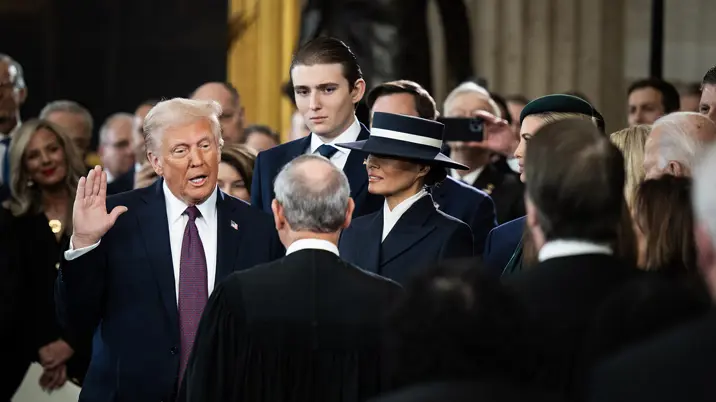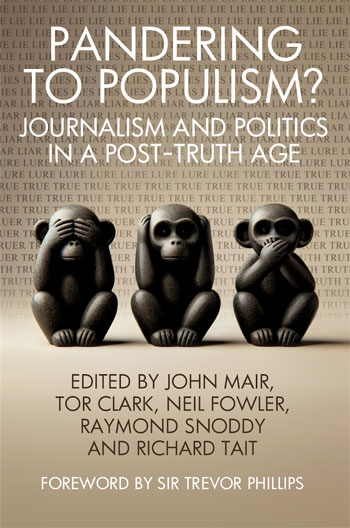
Photograph: Ike Hayman, Public domain, via Wikimedia Commons.
A survey taken by the Pew Research Center in September 2024 of US voters’ principal authority for political news found Fox News leading the field, with 13 per cent of adult respondents naming this as their main source. CNN was the only other source in double figures (10 per cent), and the heritage TV networks (NBC, ABC, CBS) were together cited by just 11 per cent of respondents. Other sources mentioned included local TV channels (six per cent), MSNBC (three per cent), NPR (the only mention of radio, three per cent), the New York Times (three per cent) and X/Twitter (two per cent). A further 32 per cent of respondents named other locations as their main sources — presumably including the increasing number of online sites sharing news and opinion. A total of 54 per cent reported getting news from social media among other sources ‘sometimes’ or ‘often’. A further breakdown from the same survey reported 20 per cent of respondents resorted to social media sites as their main political news source, eight per cent used Google or other search engines to chase the news and five per cent relied mostly on podcasts.
Explosion of digital media
The era which has seen Donald Trump emerge as a political force of major international significance has also witnessed the mushrooming of alternative media sources, with a corresponding impact on heritage TV and print producers historically considered reliable which have seemed by comparison dwarfed and diminished. Online sources were emerging in the 1990s, but it was the early 21st century which began to see exponential expansion. In 2008 it was felt the Obama presidential campaign had displayed more skill in its use of internet communications than the Republicans, but the GOP responded with alacrity, beginning to show its strength on the web by the time of Obama’s first mid-term elections in 2010.
The rapid growth of internet communications makes it difficult to find precisely comparable time series data. The questions pollsters asked when the world wide web was itself developing could not anticipate the impact and power of the internet across the spectrum of social, political and business activities. But a Pew survey found in 2010 about 75 per cent of US adults were internet users and of these 22 per cent reported using social networking sites such as Facebook, Myspace, Twitter and others to engage with that year’s elections.
The rise of social media
These American citizens used the internet to take part in the election campaigns by following particular candidates or political groups, by gathering campaign information through these contacts, by posting their own content relevant to the elections and some were energised enough to take a more active part in political groups or causes. That is, in 2010 about 16.5 per cent of the potential US electorate reported using internet social networking as some part of their election information source.
The level of electoral engagement in this form in 2010 may seem quite impressive, but the uplift from an estimated 16.5 percent of the electorate using web-based social networking as just part of their relationship to news, opinion and debate on election matters to a 2025 figure of 32 per cent using social media and related internet links as their main source, expanding to 54 per cent consulting social media for news ‘sometimes’ or ‘often’ must be seen as the most dramatic shift in the structure of political communications and in the routing of political information since the widespread introduction of television into American homes after the Second World War.
The contemporary importance of the digital sphere in US elections was highlighted in a pre-2024 election estimate predicting that while traditional news sources such as the major TV networks, radio and print would make up the majority of campaign spending, the figures for that sector were beginning to flatline, with increased spending going elsewhere. Election-related digital advertising expenditure was predicted to increase by 156 per cent over 2020 levels.
Political spending on digital outlets was estimated to reach over 28 per cent of the total outlay on the 2024 election campaigns, double the share taken by similar outlets only four years previously. This digital bundle includes digitally-delivered cable TV, and sources such as Google and YouTube, which account for most of this advertising activity. Social network advertising is modest by comparison, but considered by Paul Verna, VP of Insider Intelligence, to be ‘a focal point for conversations about hot button topics’, it is a growing sector no one should ignore. The $605m estimated expenditure in this sector is over 86 per cent higher than in 2020, with the vast majority of that funding channelled to Facebook.
The 2024 aggregate political advertising expenditure is estimated at over $12.3bn. The rapid terraforming of the political advertising landscape — especially involving such huge investment of money, time and personnel as well as shifts in media strategy — is clearly of significance to those in the business of political news. The market shifts indicated by these advertising budgets also provide strong indications of rapid changes in audience make up, and engagement with and consumption of political news.
Legacy media is dying
This evidence confirms the development of a vast and, so far, still expanding array of news sources now available. This could lead to a competitive but pluralistic journalistic environment, providing the location for balanced debate moving to co-operation and progress. While this still can’t be ruled out, many have voiced dismay the media expansion of recent years has given higher profile to sources whose narratives are unverifiable, which allow misinformation and sometimes malignly purvey disinformation.
Taylor Lorenz, in his review of the 2024 election, quoted Prof Jeff Rauchberg’s opinion that ‘legacy media is dying … [and] it’s going to accelerate pretty quickly, and people are going to turn to alternative news sources, they’re losing trust in traditional news.’ Lorenz himself sees 2024 as a key election in that social media influencers played a key role in both campaigns, but this form of political communication was embraced by the Trump campaign with an enthusiasm and expertise not seen in a Harris campaign which did not bend as much to the expectations of this emerging format.
Trump’s political career has been as a disrupter and a creator of media content. He keeps this up at all times. At the end of the now infamous February 2025 Oval Office press conference ambush of Ukraine’s President Zelenskyy by President Trump and Vice-President Vance, Trump commented: “This is going to make great television.” Whether he intended this result can be debated. That he was immediately aware of its political potential is entirely clear.
Old and new campaign platforms
In his first campaign and during his first term in office Donald Trump was perceived as a master of Twitter, tweeting over 38,000 times between the start of 2015 and the suspension of his account on January 8, 2021, two days after the insurrection at the US Capitol. But his reinstatement on Twitter in November 2022 did not produce another tsunami of tweets. His number of followers on his own wholly-owned Truth Social platform is much smaller than his former Twitter audience, but it gives him a direct line to those voters faithful to his version of the truth and, along with his continued use of the very traditional form of the political rally, it gives him the opportunity to create headlines and stories other media sources will pick up and spread. Trump’s energetic pursuit of media centrality has worked, and the public communications weaknesses in Biden’s campaign, and then Harris’ campaign, gave him considerable space in which to conduct his 2024 media campaign.
In the 21st century the US electorate has divided its support for the country’s two major political parties relatively evenly. The largest margin in the presidential elections was Obama’s 7.2 per cent lead in 2008, and twice, in 2000 and again in 2020, the election has been so close that the constitutionally decided winner has actually received fewer votes than the loser. The Trump years fit comfortably within this pattern, including his 2024 victory, with a very slim popular margin of just 1.5 per cent over Kamala Harris.
There may have been an expectation in traditional political circles that a candidate who enters vigorously into the inevitable combat of the campaign, but who is so cavalier in substituting unsupported opinion for evidence, and shows so little consideration for the manners, protocols, precedents and etiquette normally observed in politics, would fail in the pursuit of office. But a portion of the electorate, disappointed by the policies of previous administrations and especially concerned that the federal government was unwieldy and actively favoured population groups other than theirs, welcomed Donald Trump as an exciting fellow spirit, ready to tell their truths to power.
The nominee of any political party which regularly gains the support of about half of the nation’s voters can count on a core of support that is never going to defect across party political lines. Together with the body of conservative-leaning voters who might prefer a more conventional leader at the helm, but who consider a Trump presidency more likely to deliver on their personal agenda, one has the elements of an electoral coalition with the potential to win.
The electorate divided into those feeling Donald Trump is a deeply flawed man whose character should debar him from the White House and who might fundamentally destabilise American democracy and those who saw him as embodying their own concerns and capable of changing the overbearing American institutions and regulations they held responsible for the decline in their quality of life.
The polarisation of US politics
In an era when leadership politics became increasingly akin to celebrity- watching, Donald Trump became the star of the show. The expanding universe of news, information and opinion sources played a significant part in the construction and preservation of alternative political narratives. The term ‘echo chambers’ was familiar even as the Trump bandwagon got underway as a description of the clusters of media sources which reinforced, rather than debated, political ideologies. Matt Carlsson, Sue Robinson and Seth Lewis, who had examined the previous election in their book News After Trump (OUP, 2021) feel by 2024 those factors reinforced ‘a deep chasm between the information environments of right-leaning and left-leaning people. We now nurture two mainstream public discourses, and they do not overlap.’
In this environment journalistic analysis and criticism, however pointed, well-argued, evidence-based and repeated, and from whichever political base, will have diminished impact since it is mainly sermonising to the choir, rather than contributing to a debate. In this information environment untruths can be substituted for facts and can be used to trigger extreme reactions on issues campaign polling and focus groups have discovered to have considerable impact on voters’ intentions. So legitimate public concerns regarding immigration become jet-propelled by the candidate’s claim Haitians are killing and eating cats and dogs in Springfield, Ohio. The Trump campaign reportedly spent at least $215m on anti-transgender adverts in target voting areas in the late stages of the campaign, portraying Harris as an ultra-liberal ready to waste taxpayers’ hard-earned dollars on ‘woke’ projects.
The end of endorsements?
In this increasingly chaotic world of political communication, with its expanding and largely unregulated spectrum of sources, it is perhaps surprising one of the most widely discussed political journalism stories to break late in the 2024 campaign was the decision by the proprietors of The Washington Post and the Los Angeles Times to order their editors to break with recent practice and not endorse any presidential candidate. Dismay was expressed, resignations accepted, subscriptions were cancelled. Perhaps these decisions drew particular comment as the decision not to endorse was imposed in each case by billionaires, and in the case of The Washington Post by Amazon owner Jeff Bezos. But it is clear newspaper endorsements have declined considerably in recent years. About three-quarters of the leading US newspapers failed to endorse a candidate in 2024, a dramatic shift from the approximately 90 per cent who did endorse 20 years previously. There is little evidence newspaper endorsements have much impact, but it would appear anyway that opinion leadership is less and less a role America’s newspaper owners wish their outlets to display.
‘We have to straighten out the press’
If the power of heritage journalism is in decline, the instinct of the Trump team appears to remain suspicious that it is an enemy. Trump has regularly responded to critics through the courts. In December 2024, pinpointing a pre-election poll which suggested Harris was leading Trump in Iowa, a state that on election day opted for Trump by a substantial margin, he sued the Des Moines Register, its parent company Gannett, and the pollster Ann Selzer, on the grounds that publishing this poll in the late stages of the campaign constituted illegal campaign interference. ‘Our press is very corrupt,’ said Trump, and ‘we have to straighten out the press.’ At that time, before he had been inaugurated as president, he said ‘it should have been the Justice Department’ acting against the press. Once he was inaugurated, he took little time to marshal the forces of that department and others in a wide-ranging attack on the political threats he and his supporters see around them.
Key to the Trump administration’s activity has been a wide-ranging flood of presidential orders. One of the most significant and sweeping, issued a week into the new administration, ordered a pause in government ‘grant, loan and financial assistance programs’. This lists among its justifications ‘ending wokeness’ and eliminating the ‘use of Federal resources to advance Marxist equity, transgenderism, and green new deal social engineering’. Specific targets also listed included ‘financial assistance for foreign aid… DEI [and] woke gender ideology’. The response within US Government departments was widespread and confused. The Department of Defense removed web pages featuring the achievements of female, Hispanic and black veterans. The State Department asked one overseas grant recipient how their activities contributed to making America safer, stronger and more prosperous, and then withdrew the funds anyway.
Many businesses and institutions, including media, quickly closed down their Diversity, Equity and Inclusion (DEI) efforts — perhaps pleased to get rid of the expense, perhaps concerned not to be out of step with the new presidential administration. In the media sphere The Washington Post lost its ‘Opinion’ section editor to resignation as proprietor Jeff Bezos imposed limits on the range of topics that would be allowed on that page. Facebook and Instagram axed their fact checkers. X/Twitter relies on ‘community notes’, a system that is slower and less visible than having contracted fact checkers. Elon Musk, owner of X, having invested over $250m in the late stages of the Trump election campaign, was elevated by the new president to lead the Department of Government Efficiency, and went to his task energetically.
Speaking at the US Department of Justice in March 2025 President Trump continued his attack on the media, identifying particularly CNN and MSNBC as arms of the Democratic Party, and accusing them of being corrupt and illegal. With US Attorney General Pam Bondi and FBI director Kash Patel present, the President took the opportunity to claim there would be a far-reaching investigation into this alleged corruption.
Redefining the relationship
Meanwhile the White House spent the early weeks of the new administration re-defining its relationship with the media. The administration took very seriously Steve Bannon’s earlier admonition to ‘flood the zone’ with content, appointing a team of young, social media savvy, staff working out of the White House, and with some Trump Cabinet members building their own media audiences. In her first press briefing White House Press Secretary Karoline Leavitt announced the White House Correspondents’ Association would no longer be allowed to choose those members of the press pool who have access to the president for press briefings in the Oval Office or on Air Force One. Within two months of this announcement 15,000 applications had been received for the new media places in the pool.
The Trump administration hopes the White House and the multiverse of media sources are now firmly connected and working to the returned president’s advantage.


This article is a chapter from the new book, ‘Pandering to populism? Journalism and politics in a post-truth age’, edited by John Mair, Tor Clark, Neil Fowler, Raymond Snoddy and Richard Tait, published by Bite-Sized Books. Available on Amazon.
This post was originally published on this site be sure to check out more of their content







